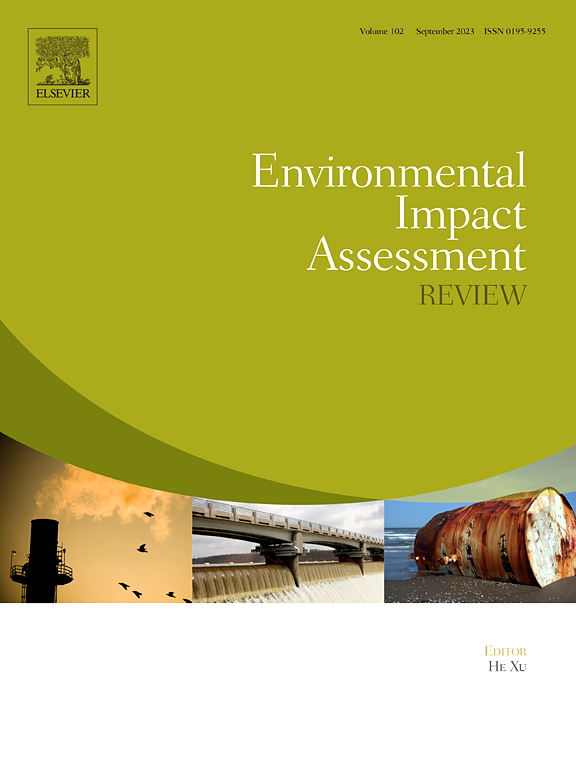Environmental performance of urban agriculture in the global south: A comprehensive literature review and life cycle analysis approach.
IF 9.8
1区 社会学
Q1 ENVIRONMENTAL STUDIES
引用次数: 0
Abstract
Urban agriculture is increasingly recognized as a strategy to enhance food security, mitigate environmental impacts, and strengthen urban resilience, particularly in the Global South, where rapid urbanization and vulnerabilities in the food system present significant challenges. This study applies a four-phase methodology to evaluate the environmental performance of urban agriculture systems. First, a systematic review identifies environmental indicators and dominant assessment methods. Second, life cycle inventory data are compiled to benchmark carbon emissions, water use, and land demands across urban agriculture typologies. Third, spatial and nutritional benchmarks are developed to evaluate caloric content, productivity, and trade-offs by crop type and production method. Fourth, an empirical validation applies these benchmarks to metabolic data from an informal settlement in Lima, Peru, testing assumptions about productivity, land use, and emissions in dense urban settings. Results show that hydroponic systems provide the highest productivity (12 kg/m2/year) and the lowest land demand (0.8 m2/kg), but also generate the highest emissions (1.5–3.0 kg CO₂eq/kg). In contrast, peri-urban farms emit less carbon (0.6–1.2 kg CO₂eq/kg) and better integrate with existing land-use patterns but require more water (1500–3500 L/kg) and land (1.5–3.5 m2/kg). The Lima case shows that decentralized food circulation can match rooftop farming yields and that small-scale interventions could supply 17–27 % of local food flows. However, current assessment frameworks often overlook the interactions between spatial typologies, design criteria, water management, and system resilience, as well as key co-benefits such as stormwater retention, thermal regulation, and improved well-being. This study highlights the need for a more integrated framework that incorporates urban and architectural typologies alongside operational and social variables to guide sustainable urban agriculture in low-income urban areas.
全球南方城市农业的环境绩效:综合文献综述和生命周期分析方法。
城市农业日益被认为是一项加强粮食安全、减轻环境影响和增强城市抵御力的战略,特别是在快速城市化和粮食系统脆弱性构成重大挑战的全球南方国家。本研究采用四阶段方法评估都市农业系统的环境绩效。首先,系统回顾确定环境指标和主导评价方法。其次,编制了生命周期清单数据,以基准碳排放、水利用和城市农业类型的土地需求。第三,制定了空间和营养基准,以评估作物类型和生产方法的热量含量、生产力和权衡。第四,实证验证将这些基准应用于秘鲁利马一个非正式住区的代谢数据,测试有关密集城市环境中生产率、土地利用和排放的假设。结果表明,水培系统提供最高的生产力(12 kg/m2/年)和最低的土地需求(0.8 m2/kg),但产生的排放量最高(1.5-3.0 kg CO₂eq/kg)。相比之下,城郊农场的碳排放量更少(0.6-1.2 kg CO₂eq/kg),与现有土地利用模式的整合更好,但需要更多的水(1500-3500 L/kg)和土地(1.5-3.5 m2/kg)。利马的案例表明,分散的粮食流通可以与屋顶农业的产量相匹配,小规模干预可以提供17 - 27%的当地粮食流量。然而,目前的评估框架往往忽略了空间类型、设计标准、水管理和系统弹性之间的相互作用,以及诸如雨水保留、热调节和改善福祉等关键的协同效益。本研究强调需要一个更加综合的框架,将城市和建筑类型以及运营和社会变量结合起来,以指导低收入城市地区的可持续城市农业。
本文章由计算机程序翻译,如有差异,请以英文原文为准。
求助全文
约1分钟内获得全文
求助全文
来源期刊

Environmental Impact Assessment Review
ENVIRONMENTAL STUDIES-
CiteScore
12.60
自引率
10.10%
发文量
200
审稿时长
33 days
期刊介绍:
Environmental Impact Assessment Review is an interdisciplinary journal that serves a global audience of practitioners, policymakers, and academics involved in assessing the environmental impact of policies, projects, processes, and products. The journal focuses on innovative theory and practice in environmental impact assessment (EIA). Papers are expected to present innovative ideas, be topical, and coherent. The journal emphasizes concepts, methods, techniques, approaches, and systems related to EIA theory and practice.
 求助内容:
求助内容: 应助结果提醒方式:
应助结果提醒方式:


